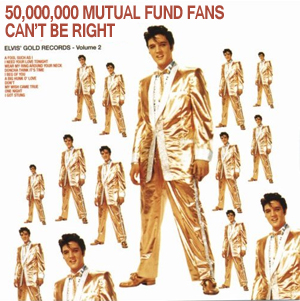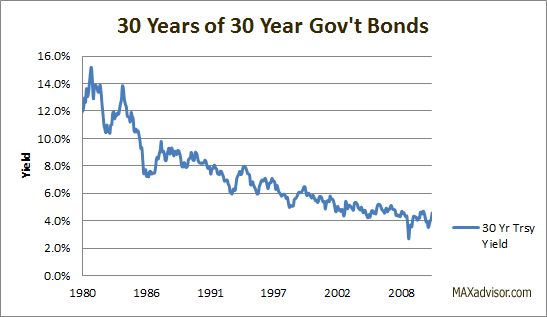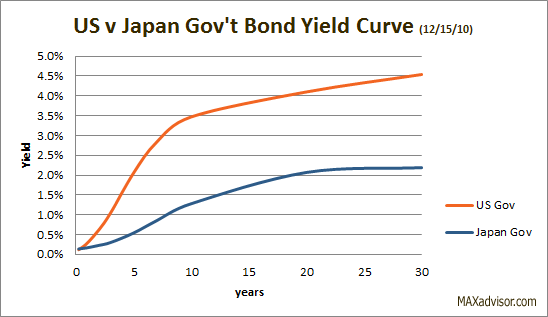The Most Sidestepped Bubble in History
Elvis Presley once had a record called “50,000,000 Elvis Fans Can't Be Wrong.” Just as true is the MAXfunds version of this famous title – “50,000,000 Fund Investors Can’t Be Right.”

In the past, we’ve warned you about bubbles in growth stocks and real estate. Now we’re warning you about the real bubble – in bonds. But the real bubble in bonds is not the one most people are talking about.
You know it’s bad when the fund companies warn you about dismal future returns in the bond market. Yet there it is – splashed on the home page of Vanguard’s personal investors site – "Vanguard’s Investment Chief Cautions Bond Investors” – a road sign that says “RISK AHEAD.”
Other major players in the bond fund market have also tried to set expectations looooow. PIMCO recently coined the "new normal" concept, which forecasts tepid returns for bonds (and stocks, and the economy as a whole…what a bunch of sourpusses).
It makes sense that although stocks are about where they were a decade ago, bonds have enjoyed a nearly uninterrupted 30-year bull market. Unlike stocks, which, in theory, can grow forever, bond prices go up when yields fall, and yields can’t fall forever. Any day now – and the experts have been saying any day now since the last recession nearly a decade ago – rates will skyrocket to their old highs (or at least somewhere between the rates of 1980 and today).
 To make matters worse, fund investors have all but given up on adding new money to stocks. In fact, they'd been pulling money out right before this recent rise in stocks (naturally) as they piled into bond funds to the tune of several hundred billion a year.
To make matters worse, fund investors have all but given up on adding new money to stocks. In fact, they'd been pulling money out right before this recent rise in stocks (naturally) as they piled into bond funds to the tune of several hundred billion a year.
2010 is for bond funds what 2000 was for stock funds: a peak in enthusiasm, but the end of a long run-up in prices. Or so the story goes.
We’ve all heard of HD, or hi-def (short for high definition TV). Well, the new bond investor is all about LD, or low duration. And therein lies the rub.
Duration is a statistical measure of interest rate sensitivity. Simplifying a bit, if a bond has a duration of ten, the price should fall 10% with a 1% move up in interest rates (or gain 10% with a 1% drop in rates). With a duration of two, the same investor will lose only 2% of their bond value. After all, if you buy a 10-year bond yielding 5% for $1,000, and rates jump to 6% the next day, no one wants to pay you $1,000 for your crummy low-yield bond.
The best protection against losing money in bonds as rates go up is owning shorter-term bonds. That way, if rates go from 5% to 6% with only 2 years left on the note, your losses will be fairly minimal. Earning $50 a year on a $1,000 bond for two years instead of $60 on a newer bond only burns you by $20 over the life of the bond.
Of course, no one really knows what interest rates will do in the future, particularly 10 or 20 years from now. There are far too many moving parts, global politics, business cycles, and presidential and Fed policies at play. Fear of the unknown and bond investors' general aversion to losing money will keep longer-term rates higher than shorter-term rates.
Interest rate risk is the reason investors have historically been advised to spread their money around the yield curve, build a so-called ladder of maturities if they own bonds directly, or just own a few different duration bond funds – some short, some intermediate, some long. This strategy protects investors from big losses if rates rise, and as importantly, protects you from another problem – the loss of income that occurs when rates sink. Pay special attention to this last part. No one else is.
One remarkable feature of the new bond bubble is how undiversified it is. Take a look at the asset levels at some of the largest bond fund families in the business, and you'll see it’s pretty clear everyone's afraid of rising rates.
Vanguard has brought in much of the billions per month in new bond money as investors have wisely chosen low-fee bond funds to maintain what paltry yield remains in bonds. At the end of October, Vanguard managed $391 billion in bond fund assets (not including over one hundred billion in money market funds). This money is spread (and not very well) around 30 distinct bond portfolios, most with multiple share classes and now ETFs.
As of 12/13/10, the average yield of these funds is 2.94% - pretty slim pickings to be sure, but not too shabby, considering that inflation is near zero. But that’s not the average yield of Vanguard investors that loaded up on shorter-term bonds with paltry yields. The weighted average yield is just 2.5%.

The weighted duration off all the dough – that measure of interest rate sensitivity – is 4.5. So if rates skyrocket by three percentage points across the yield curve in a year (which would be about the worst rise in bond yields in modern financial history,) and the ten-year treasury yields 6.5% (not the 3.5% it currently yields,) a typical Vanguard bond investor would lose about 13% after adjusting for the yield they earn on the funds during the price slide.
This means no one's more prepared for the looming doomsday in bonds than typical bond fund investors. Ninety-five percent of bond fund assets at Vanguard are in bonds with durations of seven years or less. They'll fall all the way to the ground from the first rung of the bond ladder and perhaps only sprain their ankle.
The real risk of such bond diversification (or lack thereof) is the risk the yield curve stays more or less the same for years, or perhaps begins to look more like Japan's – another country that followed twin bubbles in stocks and real estate with massive government stimulus spending.
In such a scenario, which is at least as likely as the skyrocketing rates scenario, retiring baby boomers would have to get by on sub-1% yields for the indefinite future. What if the Fed keeps short-term rates low for five years in order to get the economy going again? What if inflation rises to 2%, and they keep short-term rates at 1% to keep inflation at that level? What’s the game plan for that future? How are 76 million baby boomers going to retire on such yields?
There may be a bond bubble, but it’s in short-term bond funds. Less than 10% of Vanguard’s bond money lies in funds with “long” in the title. Long-Term Investment Grade [VWESX] tips the scales at a paltry $9.4 billion. Compare this to Vanguard Short Term Investment Grade [VFSTX], which has $38.5 billion more than ALL Vanguard long-term bond funds combined.
That’s not how bubbles work. Bubbles exist when everyone invests their money in the belief they'll get rich doing it – a mass conviction that there's far more upside than downside. That’s not what’s happening here. Today, no one believes long-term bonds have more upside than downside, NOT EVEN THE BOND FUND MANAGERS (unlike what we saw during the growth stock bubble, when nearly all fund managers predicted limitless growth as far as the eye could see).
 This will be the first bubble burst in recorded history in which typical fund investors are sitting pretty – deftly invested in short-term bonds and gold, and ready to reposition their portfolio following the big run up in rates. The trouble with this scenario is that the typical fund investor is NEVER positioned well for a bursting bubble. That’s how bubbles burst.
This will be the first bubble burst in recorded history in which typical fund investors are sitting pretty – deftly invested in short-term bonds and gold, and ready to reposition their portfolio following the big run up in rates. The trouble with this scenario is that the typical fund investor is NEVER positioned well for a bursting bubble. That’s how bubbles burst.
In bubbles, money floods into funds designed to profit from continued wealth creation. PIMCO launched a long-term bond ETF a little over a year ago called PIMCO 25+ Year Zero Coupon U.S. Treasury Index Fund (ZROZ), about the longest duration fund out there with a (yikes!) 27 duration. How much does ZROZ hold in assets? $34 million. Not far off the amount Merrill Lynch had left when they merged their ill-fated Internet Strategies fund out of existence following a roughly 70% drop. This is the same fund that brought in over a billion dollars in two weeks in March 2000 when it was launched. Now that’s a bubble. Today the most aggressive way to bet on rates going DOWN and the bond bull continuing can’t raise any money. Some bond bubble. [NOTE: At the time of this writing the author has a small position in ZROZ]
This is almost exactly how the 2000 stock bubble went down. We didn’t have a stock bubble – we had a bubble in growth stocks. Many funds with “value” in the name performed well when the pop came, and were seeing shareholder redemptions during the big run-up in growth stocks leading up to the crash.
Following the recent slide in bonds, you can now earn about 5% in Vanguard’s Long Term Bond Index (VBLTX) fund (tipping the scales with just $3.9 billion in assets) and approximately 5.6% in Long-Term Investment-Grade (VWESX). This may be a good time to note that the Vanguard 500 Index fund now yields just 1.58%.
But what if we’re wrong? Or more likely, we're early, and rates go up even more before leveling off? If you do the math, you may still do better taking even a 20% hit to principal while earning near 6% (which will climb as the bonds tank). After a few years, you’ll be square again, which is all short-term bond investors can expect with the Fed keeping rates low. Only if hordes of short-term bond investors shift to longer-term bonds following the big rise will they beat your return.
But they won’t shift. Many bond investors will remain in short-term bonds, waiting for an even bigger shoe to drop. Many will go back to CDs and money markets. Some will move out on the yield curve, which will bid up the long-term bonds again, or at least keep them from falling much farther. Do we even need the Chinese bond buyers if some of the trillions in shorter-term bonds begin moving into longer-term bonds to lock in yields?
Bottom line – there's too much money in the bond market that needs to be reallocated across the yield curve in order to allow rates to climb to double digits, even if inflation ticks up. You might as well hold your breath for dividend yields on the market to go back near the double digits, as they have been in the past.
The "new normal" is really that Wall Street has too much money to manage – the result of generations of American exceptionalism and wealth creation by the greatest economy the world has ever seen. Your best strategy remains the one that's worked throughout history: go to the least crowded investment options. Strangely, today that category is investment grade long-term bonds – the very asset that's scaring most investors, the very eye of the hurricane. Six percent taxable yields on low default risk, long-term money? C’mon. Live a little. You deserve a 6% yield.
